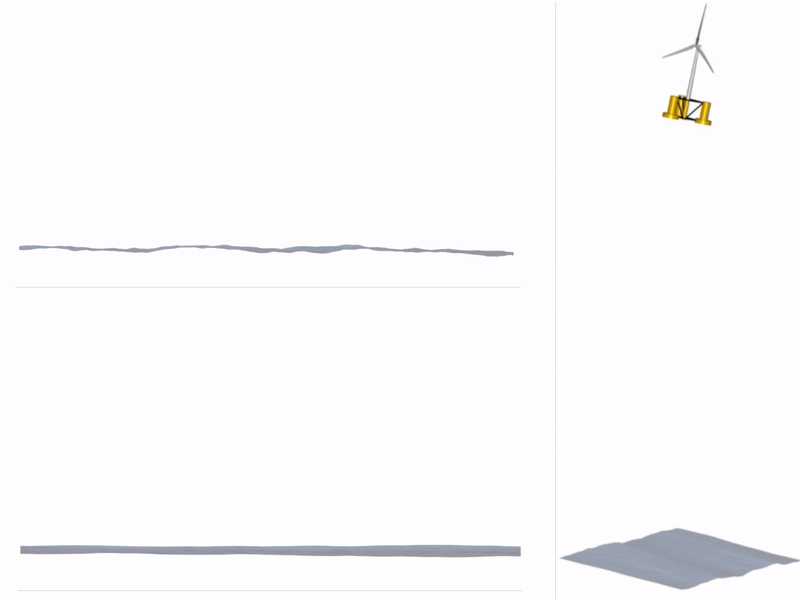Forum
Important Notice for New User Registrations
To combat an increasing number of spam and bot registrations, we now manually approve all new user registrations. While this may cause a delay until your account is approved, this step is essential to ensure the quality and security of this forum.
To help us verify your registration as legitimate, please use a clear name as user name or an official email address (such as a work, university, or similar address). If you’re concerned that we may not recognize your registration as non-spam, feel free to email us at with a request to approve your username.
Technical Inquiry: Blade Modifications and Polar Files in NREL 5MW OC4 Semisub
Quote from cherish4057 on 13. August 2025, 02:34Dear QBlade Team
I am currently working on a project to improve power generation by modifying the blade geometry of the ‘NREL 5MW OC4 Semisub’ file. I have a few technical questions regarding the simulation and data.
(https://qblade.org/downloads/#Test_Data)
I am trying to define the airfoils used in this model and need to understand the exact conditions used to generate the 360 polar data. The files seem to indicate a Reynolds number of 0.75, but when I run an airfoil analysis with this condition, the results are strange and don’t seem correct.
My question is: what are the precise conditions (e.g., Reynolds number, Mach number, analysis method) that were used to create the original 360 polar files included in the NREL 5MW OC4 Semisub example?
Because of the issue above, I attempted to create my own polar file by running an airfoil analysis in XFOIL with Re = 1.0M and then used that data to extrapolate a 360 polar.
Could you please confirm if this method is an acceptable and valid approach for my research?
In the simulation results, I can only see the power coefficient displayed in the graphs, not the actual power output. I would like to know if it is reasonable to treat the power coefficient as a direct proxy for the actual power generation, assuming other factors remain constant.
Thank you for your time and assistance. Any help you can provide would be greatly appreciated.
Sincerely,
Dear QBlade Team
I am currently working on a project to improve power generation by modifying the blade geometry of the ‘NREL 5MW OC4 Semisub’ file. I have a few technical questions regarding the simulation and data.
(https://qblade.org/downloads/#Test_Data)
I am trying to define the airfoils used in this model and need to understand the exact conditions used to generate the 360 polar data. The files seem to indicate a Reynolds number of 0.75, but when I run an airfoil analysis with this condition, the results are strange and don’t seem correct.
My question is: what are the precise conditions (e.g., Reynolds number, Mach number, analysis method) that were used to create the original 360 polar files included in the NREL 5MW OC4 Semisub example?
Because of the issue above, I attempted to create my own polar file by running an airfoil analysis in XFOIL with Re = 1.0M and then used that data to extrapolate a 360 polar.
Could you please confirm if this method is an acceptable and valid approach for my research?
In the simulation results, I can only see the power coefficient displayed in the graphs, not the actual power output. I would like to know if it is reasonable to treat the power coefficient as a direct proxy for the actual power generation, assuming other factors remain constant.
Thank you for your time and assistance. Any help you can provide would be greatly appreciated.
Sincerely,
Uploaded files:
- You need to login to have access to uploads.
Quote from David on 14. August 2025, 00:34Hello,
The aerodynamic definition of the NREL 5 MW wind turbine model in QBlade is fully based on the original specification of this turbine by NREL.
You can find the polar data on the OpenFAST Github repository:
https://github.com/OpenFAST/r-test/tree/main/glue-codes/openfast/5MW_Baseline/AeroData
I cannot provide details on how this specific polar data was originally generated. However, when generating polars with XFoil, you should select a Reynolds number representative of the turbine you are simulating. For the NREL 5 MW rotor, a Reynolds number on the order of 1E6 is generally appropriate, although you can compute the exact value based on the chord length, tip-speed ratio, and viscosity.
The simulation should also provide the absolute power output for the turbine, so there is no need to rely solely on Cp as a proxy. Could you clarify why you are unable to plot the power output? This should be possible for both steady-state BEM simulations and unsteady time-domain simulations.
BR,
David
Hello,
The aerodynamic definition of the NREL 5 MW wind turbine model in QBlade is fully based on the original specification of this turbine by NREL.
You can find the polar data on the OpenFAST Github repository:
https://github.com/OpenFAST/r-test/tree/main/glue-codes/openfast/5MW_Baseline/AeroData
I cannot provide details on how this specific polar data was originally generated. However, when generating polars with XFoil, you should select a Reynolds number representative of the turbine you are simulating. For the NREL 5 MW rotor, a Reynolds number on the order of 1E6 is generally appropriate, although you can compute the exact value based on the chord length, tip-speed ratio, and viscosity.
The simulation should also provide the absolute power output for the turbine, so there is no need to rely solely on Cp as a proxy. Could you clarify why you are unable to plot the power output? This should be possible for both steady-state BEM simulations and unsteady time-domain simulations.
BR,
David


